Sugar works perfectly for preserving vegetables through several key mechanisms that protect your food from spoilage. When you add sugar in high concentrations, it draws moisture away from harmful bacteria through plasmolysis, creating an environment where microbes can't survive. You'll find sugar binds with water molecules, reducing water activity and preventing bacterial growth while maintaining the vegetable's crisp texture and natural color. Sugar's preservation power becomes most effective at 67% concentration, blocking bacterial growth including dangerous pathogens like E. coli and Salmonella. These time-tested preservation properties reveal just the beginning of sugar's remarkable food-saving capabilities.
The Science Behind Sugar Preservation
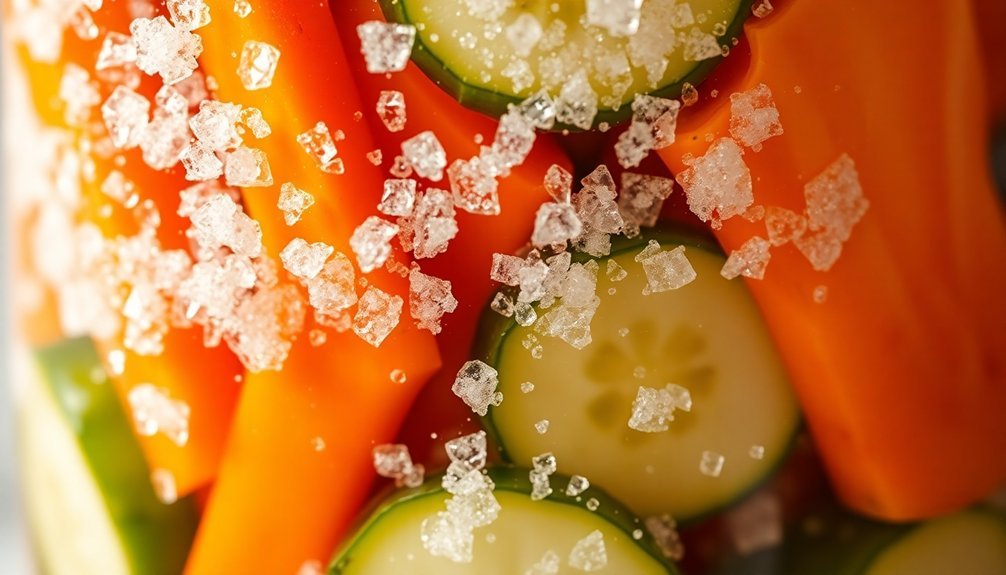
What's particularly interesting is that sugar doesn't just preserve – it enhances. It helps maintain the texture of your vegetables, prevents enzymatic browning, and contributes to a pleasing mouthfeel.
While alternative sweeteners like sucralose might seem tempting, they can't match sugar's preservation capabilities. These substitutes may add sweetness, but they won't provide the same protective benefits that make sugar such an effective natural preservative for your vegetables.
The high-concentration solution created by sugar actively draws moisture from harmful bacteria, making it an exceptionally reliable preservative for long-term vegetable storage.
Historical Roots of Sugar Storage
You'll discover that ancient trade routes played a vital role in spreading sugar preservation techniques from the Middle East to Western Europe during the Crusades.
The first documented appearance of sugar in England occurred in 1099, when it was considered a novel spice and later became available in London by 1319 at two shillings per pound.
Throughout history, sugar preservation methods have evolved from simple honey-based techniques in the Stone Age to more sophisticated approaches that you'd recognize in modern food preservation today. This preservation method was particularly effective because beneficial microorganisms were inhibited when sugar dehydrated them, making sugar an excellent choice for long-term food storage.
Ancient Trade Routes Impact
Throughout history, sugar's journey from its origins in New Guinea and Southeast Asia shaped global trade patterns and preservation techniques. You can trace sugar's transformation from a regional commodity to a global preservative through the extensive trade networks that developed over centuries.
When Arab traders learned sugar production techniques from India, they didn't just spread the commodity – they revolutionized its processing and cultivation methods. You'll find evidence of their influence in the artificial irrigation systems they developed, which allowed sugar production to flourish from Egypt to Spain. Indigenous peoples had discovered sugar's sweetness by chewing raw sugarcane thousands of years before its commercialization.
This expansion of sugar cultivation made preservation techniques more accessible across different regions. The European discovery of sugar through the Crusades and its subsequent introduction to the Americas by Columbus changed everything.
You're benefiting today from preservation methods that evolved as sugar became more readily available through the Triangular Trade. As European powers established sugar plantations in the New World, they created a steady supply that made sugar preservation more economical and widespread.
What started as a luxury spice in ancient trade became an essential preservation tool, thanks to these expanding trade routes and production capabilities.
Sugar Preservation Through Time
Ancient civilizations pioneered sugar preservation by transforming a rare commodity into a sophisticated food storage technique. They discovered that honey and concentrated sugar cane liquid could effectively preserve foods, while the Greeks and Romans advanced this knowledge by combining heated sugar with fruit pectin as an emulsifier.
You'll find that sugar's preservation power comes from its ability to draw water from microbes through plasmolysis, effectively dehydrating and killing them. This creates an environment where harmful bacteria can't survive, while also protecting the texture and shape of preserved foods.
When you combine sugar with acidic ingredients, you'll get even better preservation results for your vegetables.
Sugar's Role in Water Activity

Water activity reduction represents one of sugar's most essential roles in vegetable preservation. When you add sugar to vegetables, it creates an osmotic effect that pulls water away from the food, making it less available for harmful microorganisms to thrive.
You'll find that sugar's hygroscopic properties are particularly effective at attracting and holding onto moisture, which helps create an environment where bacteria, yeasts, and molds can't survive.
The preservation process isn't just about preventing spoilage – it's about transforming your vegetables into stable, long-lasting products. When you use sugar in proper concentrations, you're creating barriers that protect your preserved vegetables:
- You're stopping botulism in its tracks with just 50% sugar concentration
- You're blocking nearly all bacterial growth at 67% concentration
- You're extending shelf life greatly through moisture control
- You're maintaining the vegetable's quality while ensuring its safety
The secret lies in sugar's ability to bind with water molecules, creating an environment that's too hostile for microorganisms.
Microbial Control Through Sweetness
Beyond reducing water activity, sugar's role in microbial control operates through multiple mechanisms that protect your preserved vegetables. When you preserve vegetables using sugar, you're actually creating several layers of antimicrobial defense. The sugar doesn't just pull water out of microbes – it actively disrupts their cellular functions and enzyme activities, making it harder for them to survive and multiply.
You'll find sugar's preservation power is particularly effective when it's concentrated. If you're using sugar solutions similar to honey's concentration, you're creating an environment where harmful bacteria like E. coli, Salmonella, and Staphylococcus can't thrive. However, you'll need to be careful with the amount you use, as low sugar concentrations can actually encourage bacterial growth instead of preventing it.
When your vegetables ferment in the presence of sugar, you're getting additional protection through the production of ethanol and organic acids. These fermentation products create another barrier against spoilage microbes.
The sugar also weakens microbial DNA structures, further limiting their ability to survive and cause food spoilage in your preserved vegetables.
Texture and Color Enhancement

Sugar's role in vegetable preservation goes beyond just fighting microbes, as it's essential for maintaining both texture and color during storage.
You'll find that sugar helps vegetables stay firm by creating osmotic pressure that prevents cell collapse, while also protecting their natural pigments from oxidation and enzymatic breakdown.
When you're preserving vegetables, the sugar concentration in your preservation solution acts as a dual guardian, simultaneously supporting structural integrity and keeping colors vibrant.
Firm Vegetable Structure Control
Through careful control of sugar concentrations, you'll find that preserving firm vegetable structures isn't just possible – it's highly effective. When you add sugar to your preservation process, it creates an osmotic effect that draws out excess water while maintaining cellular integrity. This process helps your vegetables stay crisp and firm, unlike alternatives with sugar substitutes that can't provide the same structural benefits.
Sugar's remarkable ability to protect cellular structures becomes evident when you're processing vegetables for long-term storage. You'll notice that vegetables packed in sugar syrup maintain their shape and firmness better than those preserved without it.
Here's what makes sugar so effective for structure control:
- Your vegetables stay naturally firm because sugar replaces water in the cells, preventing collapse
- You'll avoid the frustration of mushy textures that often result from using sugar alternatives
- Your preserved vegetables maintain their appealing bite and crunch, just like fresh ones
- You can trust sugar to protect against the disappointing cellular breakdown that leads to softening
Whether you're canning, freezing, or fermenting, sugar's role in maintaining firm vegetable structure is irreplaceable.
Natural Color Retention Methods
While preserving vegetables requires attention to texture, maintaining their vibrant natural colors demands equally careful consideration. You'll find that sugar plays an essential role in preventing enzymatic browning, which often occurs when you cut or expose vegetables to air.
Sugar creates an environment that inhibits the enzymes responsible for discoloration, working alongside natural preservatives like ascorbic acid.
When you're preserving vegetables, you can utilize sugar's dehydrating properties to maintain their natural colors. The process removes moisture that bacteria and other microorganisms need to grow, while sugar coating or infusion helps lock in the original hues.
You'll notice that vegetables preserved with sugar maintain their appearance remarkably better than those preserved without it.
Sugar's ability to reduce water activity creates an inhospitable environment for microorganisms that could cause spoilage and discoloration.
When you combine sugar with acidic ingredients, you're creating a preservation system that maintains both color and freshness. The sugar concentration also helps balance flavors and textures, ensuring your preserved vegetables don't just look good but taste great too.
Through caramelization, you'll even enhance certain vegetables with appealing brown colors while improving their overall stability.
Vegetable Canning With Sugar
Contrary to popular belief, sugar plays no significant role in preserving vegetables during the canning process. Unlike fruit canning, where sugar helps maintain texture and flavor, vegetables don't require sugar for safe preservation. You'll find that boiling water or the cooking liquid from your vegetables works perfectly well as the canning medium.
When you're canning vegetables, you'll want to focus on proper techniques rather than adding sweeteners. Whether you choose the hot-pack or raw-pack method, ensuring proper liquid coverage and headspace is vital for safety.
You'll need to pack your vegetables loosely, especially starchy ones, to allow proper liquid circulation during processing.
- You're protecting your family's health by following tested safety guidelines
- You're preserving nature's bounty without unnecessary additives
- You're saving money by avoiding unnecessary ingredients
- You're maintaining the authentic taste of your garden-fresh vegetables
Remember to leave ½ inch of headspace and remove air bubbles by sliding a spatula along the jar's inside.
Always use a pressure canner for low-acid vegetables, as proper heat and steam circulation are essential for safe preservation. The processing time remains the same whether you use sugar or not, so there's no benefit to adding it.
Preservation Through Sugar Fermentation
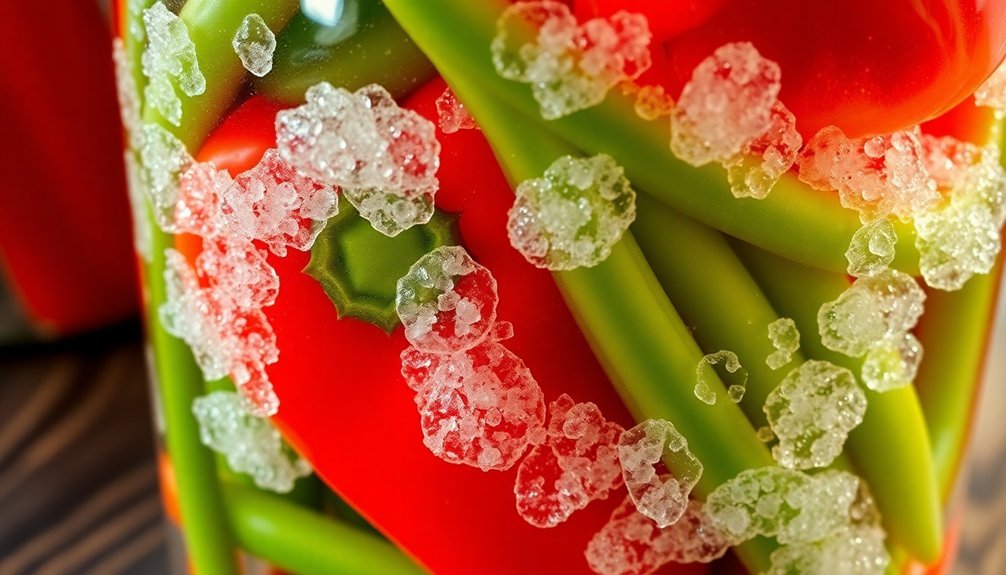
Sugar fermentation offers a fascinating preservation method that harnesses natural bacterial processes to protect your vegetables. When you add sugar to vegetables, beneficial bacteria like Lactobacillus plantarum convert it into natural preservatives such as lactic and acetic acids. These acids create an environment where harmful bacteria can't survive, ensuring your food stays safe.
To succeed with fermentation, you'll need to maintain specific conditions. Keep temperatures between 60-75°F, use non-reactive containers, and create an oxygen-reduced environment. You'll know your fermentation is working when you see bubbles forming and smell that characteristic tangy aroma.
| Stage | What You'll See | What It Means |
|---|---|---|
| Initial | Bubbling activity | Fermentation starting |
| Middle | Sour aroma developing | Acids being produced |
| Final | Clear liquid, settled vegetables | Process complete |
Once fermented, you can store your vegetables in the refrigerator for up to 3 months. For longer preservation, consider canning in a boiling water bath or freezing. The beauty of this method lies in its ability to maintain both nutritional value and probiotic benefits while creating deliciously preserved vegetables that can last for months.
Health Impacts and Considerations
Beyond the science of fermentation, understanding the health implications of sugar preservation deserves careful attention. While sugar's preservative properties are remarkable, you'll need to weigh the nutritional trade-offs carefully, especially if you're managing specific health conditions like diabetes or following a reduced-carbohydrate diet.
When you're preserving vegetables with sugar, you're fundamentally reducing their nutritional density while adding substantial calories and carbohydrates. The preservation process can affect the content of essential vitamins and minerals, making it vital to evaluate alternative methods if nutrition is your primary concern.
- You'll find yourself constantly balancing between food safety and health needs.
- Your preserved foods mightn't align with specific dietary restrictions.
- You're adding empty calories without nutritional benefits.
- You're potentially compromising the natural goodness of vegetables.
If you're contemplating sugar preservation, you'll need to implement additional preservation techniques to minimize sugar content while maintaining food safety. Think about using alternative preservation methods, combining acidity and heat treatment with reduced sugar content.
Remember that commercially available low-sugar alternatives exist, though they may come at a higher cost and might require different storage conditions to guarantee safety.
Modern Sugar Preservation Methods
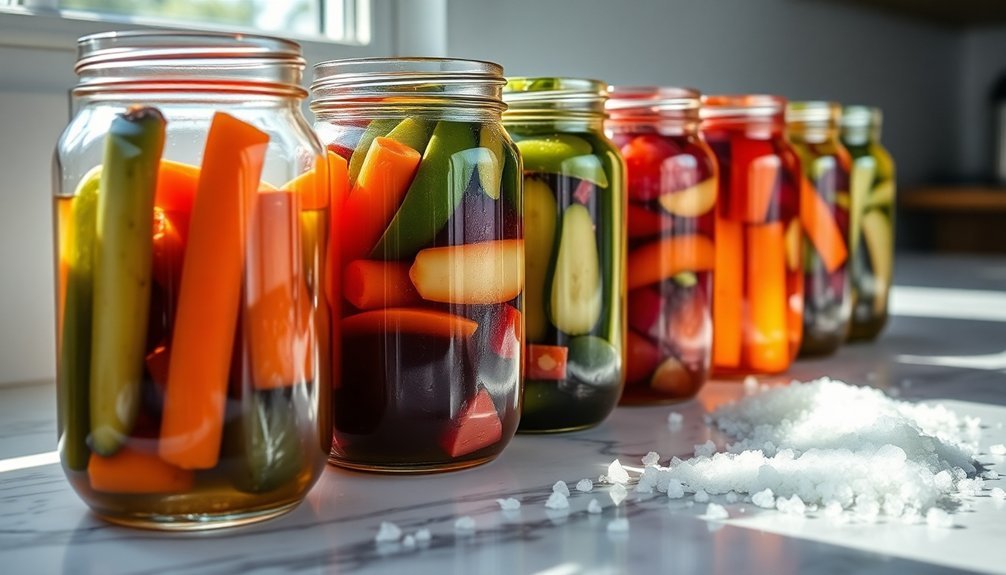
In today's food preservation landscape, you'll find a diverse array of modern sugar preservation techniques that combine traditional methods with technological advances.
You can now preserve vegetables using sophisticated syrup preservation systems that precisely control sugar concentrations to achieve ideal osmotic pressure, effectively dehydrating bacterial cells and preventing microbial growth.
Modern canning methods have revolutionized sugar-based preservation by incorporating precise temperature and pressure controls during the filling and sealing process.
You'll notice that sugar's role in canning extends beyond sweetening – it helps maintain texture and enhance shelf stability.
When you're freezing vegetables, you can use sugar solutions to protect against ice crystal damage and maintain better quality during storage.
The integration of modified atmosphere technology with sugar preservation gives you enhanced control over the preservation process.
You'll achieve better results by combining sugar preservation with controlled gas compositions that slow ripening and extend shelf life.
While irradiation isn't as widely accepted, it's another modern option you can consider, especially when combined with sugar preservation methods to achieve longer-lasting, safer preserved vegetables.
Sugar Alternatives in Preservation
You'll find several effective alternatives to traditional sugar preservation, including natural sweeteners combined with flavonoids and citrus-based compounds.
When you're looking to reduce sugar content, you can pair these natural alternatives with chemical preservatives like citric acid and ascorbic acid to maintain food quality.
Your preserved vegetables will maintain better texture and color when you combine multiple preservation methods, though you should expect some differences in the final product compared to traditional sugar preservation.
Natural Sugar Substitutes
Several natural alternatives to granulated sugar can effectively preserve vegetables and fruits while offering unique flavor profiles.
You'll find that fruit juices work exceptionally well as sugar substitutes in canning and freezing. For instance, you can pair apple juice with peaches and pears, while grape juices complement cherries and plums perfectly.
Honey serves as another versatile sugar substitute, though you'll want to use it carefully. You can replace up to half of the required table sugar with honey in your canning syrups, but remember that it's sweeter than granulated sugar, so you'll need less.
Choose light, mild-flavored honey to maintain the natural taste of your preserved foods.
- Feel confident knowing you're using nature's own sweeteners instead of artificial alternatives
- Enjoy the satisfaction of creating unique flavor combinations with fruit juice pairings
- Experience the pride of preserving family traditions while exploring healthier options
- Savor the peace of mind that comes from understanding exactly what's in your preserved foods
When using these natural alternatives, you'll need to take into account texture and storage requirements, as they can affect the final product differently than traditional sugar.
Chemical Preservative Combinations
Understanding chemical preservative combinations becomes essential when replacing sugar in food preservation methods. When you're looking to substitute traditional sugar, you'll need to take into account how different preservatives work together to maintain food safety and quality.
You'll find that most sugar alternatives can't replicate sugar's multi-functional preservation properties on their own. While sucralose offers heat stability, it won't preserve texture or create the thick syrup needed for proper preservation. You'll need to combine it with other preservatives to achieve similar results to sugar.
| Preservative Combination | Primary Function |
|---|---|
| Sucralose + Pectin | Texture stability |
| Acids + Heat Treatment | Microbial control |
| Salt + Sugar Alternative | Osmotic balance |
| Natural Juice + Sucralose | Flavor preservation |
When you're preserving vegetables, you'll need to compensate for sugar's missing preservation properties by using additional techniques. Think about using hot-fill methods, increasing acidity levels, or incorporating pectin syrups to maintain food quality. Remember that while these combinations can work effectively, they may alter the final taste and texture of your preserved vegetables differently than traditional sugar-based methods.
Preservation Effectiveness Comparison
Three critical factors distinguish sugar's preservation effectiveness from its alternatives: water activity reduction, microbial control, and texture maintenance. When you're comparing sugar to alternative sweeteners for preservation, you'll find that sugar creates an inhospitable environment for microorganisms, while alternatives like sucralose and stevia don't offer the same protective benefits.
Sugar's hygroscopic properties actively pull moisture away from bacteria and molds, making it uniquely effective for long-term food storage.
- You can't rely on artificial sweeteners to maintain your vegetables' crisp texture and vibrant colors – only real sugar delivers these essential preservation qualities.
- Your preserved foods won't be properly protected against harmful microorganisms if you use sugar alternatives alone.
- You'll notice significant texture and shape deterioration when using substitutes, as they don't provide sugar's structural support.
- Your preservation efforts may fail completely if you depend on alternative sweeteners that break down under heat or acidic conditions.
While sugar alternatives might help reduce calories, they can't replicate sugar's preservation properties. If you're preserving vegetables, you'll need to either use real sugar or combine alternatives with additional preservation methods to guarantee food safety and quality.
Storage and Shelf Life
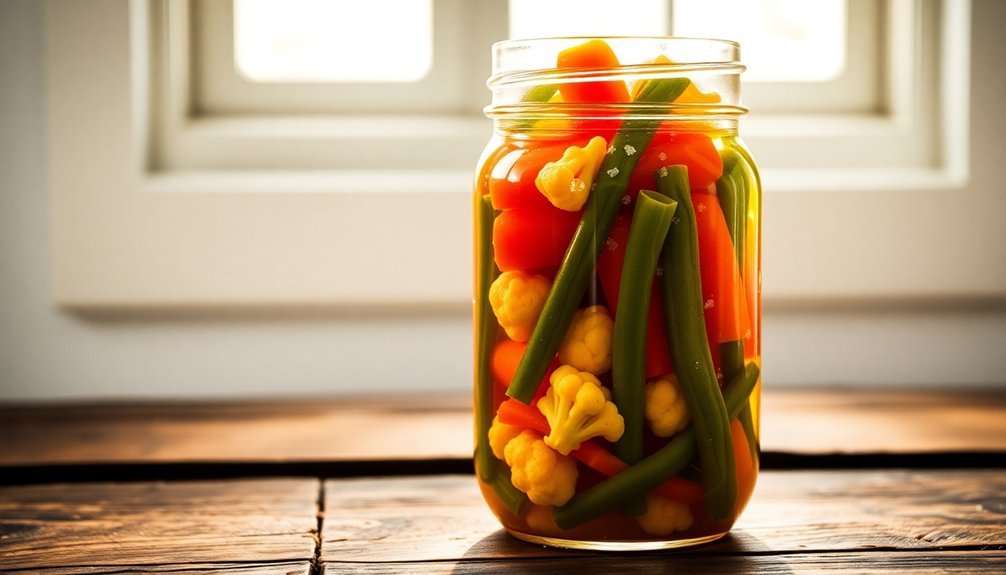
Proper storage of sugar is essential for successful vegetable preservation. You'll need to keep your sugar in a cool, dry location using airtight, moisture-proof containers like polyethylene bags or food-grade plastic buckets.
Don't refrigerate your sugar, as this can introduce unwanted moisture and cause clumping. It's also important to keep sugar away from strong odors since it can absorb them even through plastic packaging.
When you store sugar correctly, it has an indefinite shelf life, though you might notice some quality changes after about two years. If your sugar becomes lumpy, don't worry – you can easily restore it by chopping it up or dissolving it in hot water.
For liquid sugars and syrups used in preservation, avoid extreme temperatures to prevent crystallization and flavor changes.
In vegetable preservation applications, sugar's longevity makes it an ideal preservative. When you use it in jams, jellies, and fermented vegetables, the sugar continues working effectively as long as you maintain proper storage conditions.
It'll keep creating that essential low-water environment that prevents microbial growth while maintaining the preserved vegetables' color, texture, and flavor.
Frequently Asked Questions
Can Sugar-Preserved Vegetables Be Used in Savory Cooking Without Tasting Too Sweet?
Yes, you can use sugar-preserved vegetables in savory dishes without overwhelming sweetness. Just rinse them before use, balance with savory ingredients, and control portions. They'll add depth to your cooking without being too sweet.
How Do Different Types of Sugar Affect the Preservation Process?
You'll find crystalline sugars work best for firm dehydration, while liquid sugars like honey act as humectants. Both reduce water activity, but liquid sugars can increase fermentation risk if moisture levels aren't controlled.
Does Altitude Affect the Sugar Concentration Needed for Effective Preservation?
You won't need to adjust sugar concentrations for preservation at different altitudes. While altitude affects baking, it doesn't impact the osmotic properties of sugar that make it effective for preserving fruits and vegetables.
What Vegetables Are Unsuitable for Sugar Preservation Methods?
You'll want to avoid preserving water-rich vegetables like cucumbers, tomatoes, zucchini, bell peppers, and okra with sugar alone. Their high moisture content makes them prone to spoilage despite sugar's preservative properties.
Can Sugar-Preserved Vegetables Be Safely Processed Again if Initially Unsuccessful?
Yes, you can safely re-process sugar-preserved vegetables if your initial attempt fails. Just guarantee you follow proper canning guidelines, maintain correct heat treatment, and don't let sugar content interfere with heat penetration during processing.
In Summary
You've learned that sugar's incredible preserving power comes from its ability to reduce water activity and inhibit microbial growth. Whether you're canning fruits or making jams, sugar's dual role in preservation and flavor enhancement makes it an essential ingredient. While modern alternatives exist, traditional sugar preservation remains effective and reliable. Just remember to balance preservation needs with health considerations when choosing your sweetening and storage methods.

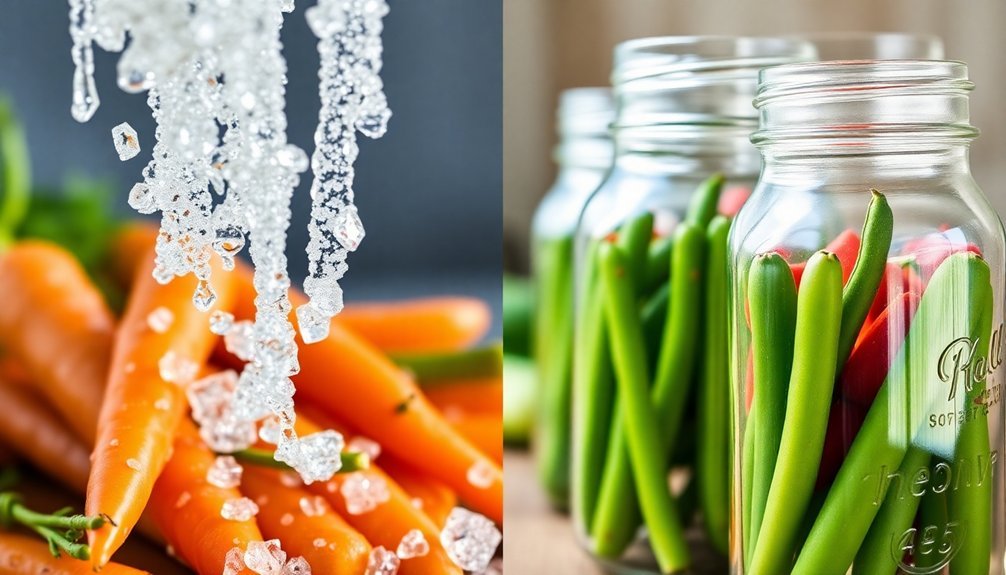



Leave a Reply